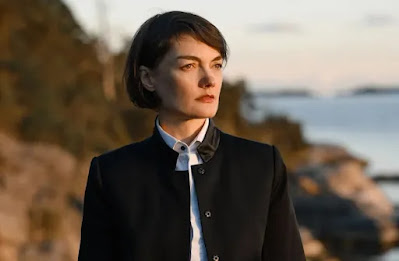 |
| Lotte Betts-Dean © Ben Ealovega |
Brighton Philharmonic Orchestra
Geoffrey Paterson (Conductor)
Joanna MacGregor (Music Director)
7.30pm, Saturday 27 January 2024
Dome Concert Hall, Brighton
★★★★
Györgi Ligeti (1923-2006): Atmosphères
Luciano Berio (1925-2003): Folk Songs
Richard Wagner (1813-1883): The Ring: An Orchestral Adventure
arranged by Henk de Vlieger (b.1953)
 |
| Geoffrey Paterson |
In the understandably short first half, the BPO gave us two challenging and highly contrasting twentieth century works, and there was no sense of these being there purely as filler. Ligeti’s Atmosphères may be known to some from its appearance in Kubrick’s 2001: A Space Odyssey, where it provides an other-worldly sense of suspension in time and space. Consisting of dense cluster chords of up to fifty or more pitches at once, these ‘sound masses’ create that sense of suspension, and what movement there is, is almost indiscernible within the density of textures, with the dynamic only rising above quiet on a couple of occasions. Conductor Geoffrey Paterson took the BPO through this with taut control, and by and large, they successfully achieved the desired effect. There were shimmering, strange oscillations and glassy strings, with the woodwind leading one of the crescendi up to four strikingly shrill piccolos. Towards the end two percussionists sweep and stroke the strings inside the piano, adding to the ethereal effect, as well as providing a little extra on-stage interest.
 |
| Lotte Betts-Dean, Geoffrey Paterson & the BPO © Nick Boston |
And so to Wagner. Despite the risk of being dismissed as a bit of a ‘greatest hits’ compilation, Henk de Vlieger’s arrangement nevertheless manages to include most of the major musical themes and motifs, with some vocal lines covered instrumentally, obviously, but also keeps much of the orchestral textures preserved, meaning that overall, this does actually work as a stand-alone orchestral piece. Here, programme notes taking us through the synopsis of the four operas, distilled by de Vlieger into fourteen sections, were supplemented by somewhat sketchy surtitles. The orchestra may well have been the largest iteration of BPO, certainly that I’ve ever seen, with a mammoth brass section including eight horns (four of whom doubled on Wagner tubas) – oh, and of course, the anvils. Paterson steered them through the adventure with remarkable energy and drive – this is definitely a feat of stamina, and to their credit, they kept the energy levels high right through. The frolicking Rhinemaidens were joyous, and the flowing Rhine itself from the strings had suitably swirling, watery atmosphere. On the whole, the brass delivered, particularly glorious when evoking the World’s Light appearing as Siegfried wakes Brünnhilde with a kiss, and Siegfried’s subsequent riding away on her steed. Inevitably with so much reliance on the brass, there were some lapses in precision later on, but overall, the excitement and commitment made up for the occasional lack of shine and finesse. The BPO woodwinds continue to show their proficiency, with some particularly evocative birds in the forest, and desperate cries at the death of Siegfried, whilst the string sound was rich and ensemble tight throughout. Hagen’s stabs that kill Siegfried could have had a little more strength and violence, but the final climactic fire of Valhalla, followed by the majestic overpowering by the Rhine brought things to a suitably exhilarating conclusion. Hats off to all concerned for an impressively dramatic performance – an orchestral adventure it certainly was!
 |
| Geoffrey Paterson & the Brighton Philharmonic Orchestra © Nick Boston |

